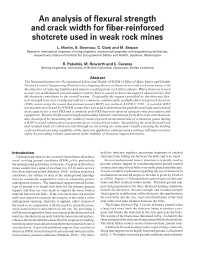Mining Publication: An Analysis of Flexural Strength and Crack Width for Fiber-Reinforced Shotcrete Used in Weak Rock Mines
Original creation date: January 2011
The National Institute for Occupational Safety and Health (NIOSH), Office of Mine Safety and Health, Ground Control Engineering Branch is investigating the use of shotcrete in weak rock mass mines with the objective of reducing fatalities and injuries resulting from rock fall accidents. When shotcrete is used as part of a multielement ground support system, there is a need to know the support characteristics that the shotcrete contributes to the overall system. To quantify the support provided by the shotcrete, flexural strength tests were conducted with two common, commercially available fiber-reinforced shotcrete (FRS) mixes using the round determinant panel (RDP) test method, ASTM C 1550. A portable RDP test machine developed by NIOSH researchers was used to determine the peak flexural load and residual load capacity for a steel FRS and a synthetic poly FRS that were sprayed using dry mix procedures and equipment. Besides the flexural strength and loading behavior determined from these tests, a method was also developed for measuring the width of cracks exposed on the underside of a shotcrete panel during a RDP test and relating these measurements to residual load values. Quantifying the peak flexural load and residual loads of a shotcrete mix through on site testing at a mine and visually assessing the loading cycle and load-carrying capability of the shotcrete applied to underground workings will improve mine safety by providing a better assessment of the stability of shotcrete supported entries.
Authors: LA Martin, JB Seymour, CC Clark, MA Stepan, R Pakalnis, M Roworth, C Caceres
Peer Reviewed Journal Article - January 2011
NIOSHTIC2 Number: 20038048
Trans Soc Min Metal Explor TP-09-062, 2011 Jan; 328:542-549
See Also
- Anchorage Pull Testing for Fully Grouted Roof Bolts
- A Correlation Between Seismic Tomography, Seismic Events and Support Pressure
- Diagnosing and Controlling Moisture-Sensitive Roof in Coal Mines
- Early Strength Performance of Modern Weak Rock Mass Shotcrete Mixes
- Field Performance Testing of Fully Grouted Roof Bolts
- The Ground Response Curve, Pillar Loading and Pillar Failure in Coal Mines
- Neural Network Technology for Strata Strength Characterization
- A Shotcrete Adhesion Test System for Mining Applications
- A Static Fatigue Constitutive Law for Joints in Weak Rock
- Tests of Fibre-Reinforced Shotcrete at the Chief Joseph Mine, Butte, Montana
- Content source: National Institute for Occupational Safety and Health, Mining Program


 ShareCompartir
ShareCompartir
